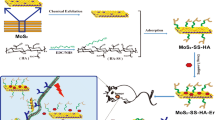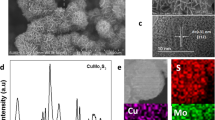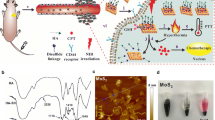Abstract
Harsh photothermal temperatures (> 50 °C) caused heating damage to the normal tissues and induced thermal resistance in cancer cells, which significantly limited the safety and efficacy of photothermal therapy (PTT) in cancer treatment. Mild hyperthermia (< 42 °C) combined with chemotherapy might solve this issue. Herein, a novel transition metal dichalcogenides nanostructure, namely, Bi2Se3/MoSe2 nanosaucers (BMNSs), was designed to produce mild photo-hyperthermia (mPTT) and combined with chemotherapy to improve the overall antitumor efficacy. The BMNSs were constituted by Bi2Se3 hexagonal nanoplates and enclosed with MoSe2 nanosheets evenly. While the MoSe2 moiety endowed the nanoplatform with excellent photothermal efficacy, the Bi2Se3 substrates provided large specific surface area to anchor more doxorubicin (DOX) molecules as chemotherapeutic agent. Under the stimuli of mPTT/tumor acidic microenvironment, the tumor-specific drug release and the enhanced chemotherapy could be realized, showing impressive therapeutic outcomes against 4T1 cells. The synergetic therapeutic mechanism might be attributed to the mPTT induced cell membrane permeability, and interestingly, the expression of heat shock proteins 70 was not elevated obviously after the synergetic therapy, thus to avoid the tumor thermal resistance and further improve the therapeutic effect. The in vivo anti-tumoral performance of the BMNSs was further studied and complete tumor eradication was achieved without any recurrence and biotoxicity. Not only demonstrating a paradigm of high therapeutic efficacy of mild hyperthermia and synergistic chemotherapy for precise cancer therapy, our findings proved that the cancer therapeutic effect can be improved with minimal side effects through exquisite designing of the microstructures and the physiochemical properties of the nanoplatform.

Similar content being viewed by others
References
Chen, C.; Ou, H. L.; Liu, R. H.; Ding, D. Regulating the photophysical property of organic/polymer optical agents for promoted cancer phototheranostics. Adv. Mater. 2020, 32, 1806331.
Gai, S. L.; Yang, G. X.; Yang, P. P.; He, F.; Lin, J.; Jin, D. Y.; Xing, B. G. Recent advances in functional nanomaterials for light-triggered cancer therapy. Nano Today 2018, 19, 146–187.
Huang, X. J.; Zhang, W. L.; Guan, G. Q.; Song, G. S.; Zou, R. J.; Hu, J. Q. Design and functionalization of the nir-responsive photothermal semiconductor nanomaterials for cancer theranostics. Acc. Chem. Res. 2017, 50, 2529–2538.
Beik, J.; Abed, Z.; Ghoreishi, F. S.; Hosseini-Nami, S.; Mehrzadi, S.; Shakeri-Zadeh, A.; Kamrava, S. K. Nanotechnology in hyperthermia cancer therapy: From fundamental principles to advanced applications. J. Control. Release 2016, 235, 205–221.
Jeong, H.; Park, W.; Kim, D. H.; Na, K. Dynamic nanoassemblies of nanomaterials for cancer photomedicine. Adv. Drug Deliv. Rev. 2021, 177, 113954.
Li, X. S.; Lovell, J. F.; Yoon, J.; Chen, X. Y. Clinical development and potential of photothermal and photodynamic therapies for cancer. Nat. Rev. Clin. Oncol. 2020, 17, 657–674.
Li, X. Q.; Pan, Y. C.; Chen, C.; Gao, Y. F.; Liu, X. L.; Yang, K. Y.; Luan, X. W.; Zhou, D. T.; Zeng, F.; Han, X. et al. Hypoxia-responsive gene editing to reduce tumor thermal tolerance for mild-photothermal therapy. Angew. Chem., Int. Ed. 2021, 133, 21370–21374.
Zhou, J.; Li, M. H.; Hou, Y. H.; Luo, Z.; Chen, Q. F.; Cao, H. X.; Huo, R. L.; Xue, C. C.; Sutrisno, L.; Hao, L. et al. Engineering of a nanosized biocatalyst for combined tumor starvation and low-temperature photothermal therapy. ACS Nano 2018, 12, 2858–2872.
Chang, M. Y.; Hou, Z. Y.; Wang, M.; Li, C. X.; Lin, J. Recent advances in hyperthermia therapy-based synergistic immunotherapy. Adv. Mater. 2021, 33, 2004788.
Gao, G.; Sun, X. B.; Liang, G. L. Nanoagent-promoted mild-temperature photothermal therapy for cancer treatment. Adv. Funct. Mater. 2021, 31, 2100738.
Wang, L. N.; Yu, Y. J.; Wei, D. S.; Zhang, L. P.; Zhang, X. Y.; Zhang, G. X.; Ding, D.; Xiao, H. H.; Zhang, D. Q. A systematic strategy of combinational blow for overcoming cascade drug resistance via NIR-light-triggered hyperthermia. Adv. Mater. 2021, 33, 2100599.
Vaupel, P.; Horsman, M. R. Tumour perfusion and associated physiology: Characterization and significance for hyperthermia. Int. J. Hyperthermia 2010, 26, 209–210.
Yang, Z. S.; Yao, Y. H.; Sedgwick, A. C.; Li, C. C.; Xia, Y.; Wang, Y.; Kang, L.; Su, H. M.; Wang, B. W.; Gao, S. et al. Rational design of an “all-in-one” phototheranostic. Chem. Sci. 2020, 11, 8204–8213.
Krawczyk, P. M.; Eppink, B.; Essers, J.; Stap, J.; Rodermond, H.; Odijk, H.; Zelensky, A.; van Bree, C.; Stalpers, L. J.; Buist, M. R. et al. Mild hyperthermia inhibits homologous recombination, induces BRCA2 degradation, and sensitizes cancer cells to poly (ADP-ribose) polymerase-1 inhibition. Proc. Natl. Acad. Sci. USA 2011, 108, 9851–9856.
Oei, A. L.; Kok, H. P.; Oei, S. B.; Horsman, M. R.; Stalpers, L. J. A.; Franken, N. A. P.; Crezee, J. Molecular and biological rationale of hyperthermia as radio- and chemosensitizer. Adv. Drug Deliv. Rev. 2020, 163–164, 84–97.
Tabish, T. A.; Dey, P.; Mosca, S.; Salimi, M.; Palombo, F.; Matousek, P.; Stone, N. Smart gold nanostructures for light mediated cancer theranostics: Combining optical diagnostics with photothermal therapy. Adv. Sci. 2020, 7, 1903441.
Rastinehad, A. R.; Anastos, H.; Wajswol, E.; Winoker, J. S.; Sfakianos, J. P.; Doppalapudi, S. K.; Carrick, M. R.; Knauer, C. J.; Taouli, B.; Lewis, S. C. et al. Gold nanoshell-localized photothermal ablation of prostate tumors in a clinical pilot device study. Proc. Natl. Acad. Sci. USA 2019, 116, 18590–18596.
Yang, X.; Yang, M. X.; Pang, B.; Vara, M.; Xia, Y. N. Gold nanomaterials at work in biomedicine. Chem. Rev. 2015, 115, 10410–10488.
Mulens-Arias, V.; Nicolás-Boluda, A.; Pinto, A.; Balfourier, A.; Carn, F.; Silva, A. K. A.; Pocard, M.; Gazeau, F. Tumor-selective immune-active mild hyperthermia associated with chemotherapy in colon peritoneal metastasis by photoactivation of fluorouracil-gold nanoparticle complexes. ACS Nano 2021, 15, 3330–3348.
Xu, C.; Nam, J.; Hong, H.; Xu, Y.; Moon, J. J. Positron emission tomography-guided photodynamic therapy with biodegradable mesoporous silica nanoparticles for personalized cancer immunotherapy. ACS Nano 2019, 13, 12148–12161.
Fan, W. P.; Lu, N.; Shen, Z. Y.; Tang, W.; Shen, B.; Cui, Z. W.; Shan, L. L.; Yang, Z.; Wang, Z. T.; Jacobson, O. et al. Generic synthesis of small-sized hollow mesoporous organosilica nanoparticles for oxygen-independent X-ray-activated synergistic therapy. Nat. Commun. 2019, 10, 1241.
Li, J. C.; Duan, H. W.; Pu, K. Y. Nanotransducers for near-infrared photoregulation in biomedicine. Adv. Mater. 2019, 31, 1901607.
Loh, K. P.; Ho, D.; Chiu, G. N. C.; Leong, D. T.; Pastorin, G.; Chow, E. K. H. Clinical applications of carbon nanomaterials in diagnostics and therapy. Adv. Mater. 2018, 30, 1802368.
Zhu, S.; Gong, L. J.; Xie, J. N.; Gu, Z. J.; Zhao, Y. L. Design, synthesis, and surface modification of materials based on transition-metal dichalcogenides for biomedical applications. Small Methods 2017, 1, 1700220.
Li, X.; Shan, J. Y.; Zhang, W. Z.; Su, S.; Yuwen, L. H.; Wang, L. H. Recent advances in synthesis and biomedical applications of two-dimensional transition metal dichalcogenide nanosheets. Small 2017, 13, 1602660.
Cheng, L.; Wang, X. W.; Gong, F.; Liu, T.; Liu, Z. 2D nanomaterials for cancer theranostic applications. Adv. Mater. 2020, 32, 1902333.
Kalantar-zadeh, K.; Ou, J. Z.; Daeneke, T.; Strano, M. S.; Pumera, M.; Gras, S. L. Two-dimensional transition metal dichalcogenides in biosystems. Adv. Funct. Mater. 2015, 25, 5086–5099.
Liu, T.; Wang, C.; Gu, X.; Gong, H.; Cheng, L.; Shi, X. Z.; Feng, L. Z.; Sun, B. Q.; Liu, Z. Drug delivery with PEGylated MoS2 nanosheets for combined photothermal and chemotherapy of cancer. Adv. Mater. 2014, 26, 3433–3440.
Gao, F.; Miao, Y. Q.; Ma, H. J.; Zhang, T. B.; Fan, H. M.; Zhao, L. Y. Boosting the photothermal performance of vacancy-rich MoSe2−x nanoflowers for photoacoustic imaging guided tumor chemophotothermal therapy. Nanoscale 2021, 13, 14960–14972.
Yang, J.; Wang, C. D.; Ju, H. X.; Sun, Y.; Xing, S. Q.; Zhu, J. F.; Yang, Q. Integrated quasiplane heteronanostructures of MoSe2/Bi2Se3 hexagonal nanosheets: Synergetic electrocatalytic water splitting and enhanced supercapacitor performance. Adv. Funct. Mater. 2017, 27, 1703864.
Yu, N.; Li, J. N.; Wang, Z. J.; Yang, S. Y.; Liu, Z. X.; Wang, Y. S.; Zhu, M. F.; Wang, D. B.; Chen, Z. G. Blue Te nanoneedles with strong nir photothermal and laser-enhanced anticancer effects as “all-in-one” nanoagents for synergistic thermo-chemotherapy of tumors. Adv. Healthc. Mater. 2018, 7, 1800643.
Ma, N.; Zhang, M. K.; Wang, X. S.; Zhang, L.; Feng, J.; Zhang, X. Z. NIR light-triggered degradable MoTe2 nanosheets for combined photothermal and chemotherapy of cancer. Adv. Funct. Mater. 2018, 28, 1801139.
Zhang, T. R.; Ge, J. P.; Hu, Y. X.; Yin, Y. D. A general approach for transferring hydrophobic nanocrystals into water. Nano Lett. 2007, 7, 3203–3207.
Cheng, Y.; Chang, Y.; Feng, Y. L.; Jian, H.; Wu, X. Q.; Zheng, R. X.; Xu, K. Q.; Zhang, H. Y. Bismuth sulfide nanorods with retractable zinc protoporphyrin molecules for suppressing innate antioxidant defense system and strengthening phototherapeutic effects. Adv. Mater. 2019, 31, 1806808.
Yin, W. Y.; Yan, L.; Yu, J.; Tian, G.; Zhou, L. J.; Zheng, X. P.; Zhang, X.; Yong, Y.; Li, J.; Gu, Z. J. et al. High-throughput synthesis of single-layer MoS2 nanosheets as a near-infrared photothermal-triggered drug delivery for effective cancer therapy. ACS Nano 2014, 8, 6922–6933.
Yang, Z.; Fan, W. P.; Tang, W.; Shen, Z. Y.; Dai, Y. L.; Song, J. B.; Wang, Z. T.; Liu, Y.; Lin, L. S.; Shan, L. L. et al. Near-infrared semiconducting polymer brush and pH/GSH-responsive polyoxometalate cluster hybrid platform for enhanced tumor-specific phototheranostics. Angew. Chem., Int. Ed. 2018, 57, 14101–14105.
Bhosale, S. V.; Al Kobaisi, M.; Jadhav, R. W.; Jones, L. A. Flower-like superstructures: Structural features, applications and future perspectives. Chem. Rec. 2021, 21, 257–283.
Yang, S. X.; Xiao, H. Y.; Cao, L. Recent advances in heat shock proteins in cancer diagnosis, prognosis, metabolism and treatment. Biomed. Pharmacother. 2021, 142, 112074.
Ma, W.; Guan, X. Y.; Li, J.; Pan, R. H.; Wang, L. Y.; Liu, F. J.; Ma, H. Y.; Zhu, S. J.; Hu, J.; Ruan, Y. L. et al. Mitochondrial small heat shock protein mediates seed germination via thermal sensing. Proc. Natl. Acad. Sci. USA 2019, 116, 4716–4721.
Acknowledgements
The authors wish to acknowledge the National Natural Science Foundation of China for the financial support (Nos. 51971116, 81771981, and 32001005), Shaanxi Provincial Science and Technology Department for financial support (No. 2021JM-476), and Shaanxi Provincial Administration of Traditional Chinese Medicine for financial support (No. 20211-ZZ-JC007).
Author information
Authors and Affiliations
Corresponding authors
Electronic Supplementary Material
12274_2022_4470_MOESM1_ESM.pdf
Mild hyperthermia synergized chemotherapy by Bi2Se3/MoSe2 nanosaucers for cancer treatment with negligible thermal resistance
Rights and permissions
About this article
Cite this article
Gao, F., Zhang, T., Miao, Y. et al. Mild hyperthermia synergized chemotherapy by Bi2Se3/MoSe2 nanosaucers for cancer treatment with negligible thermal resistance. Nano Res. 15, 8270–8280 (2022). https://doi.org/10.1007/s12274-022-4470-8
Received:
Revised:
Accepted:
Published:
Issue Date:
DOI: https://doi.org/10.1007/s12274-022-4470-8




